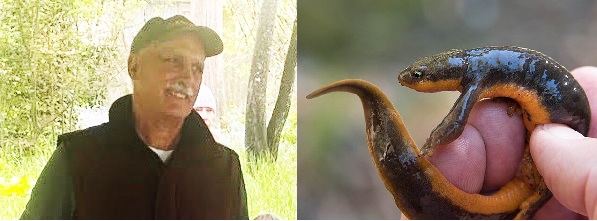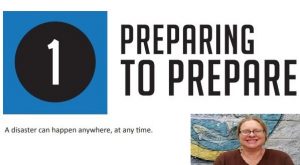Tom Titus and Nearby Nature helpers count the newts in Tugman Creek
11 min read
The nonprofit education group Nearby Nature conducted its ninth annual count of the number of newts in Tugman Park. Families and volunteers split into two teams, then worked their way from either end of Tugman Creek to meet in the middle and share their findings. On April 27:
Tom Titus: …1994, we’d come to Tugman Park and there were signs along the creek that essentially warned you to stay out of the water because it was so polluted. And the reason it was so polluted is because there’s an old dump site right up here toward the upper end of the park. It’s been closed for decades, but nevertheless, none of the materials that were dumped in there were ever removed.
So, one thing led to another, there was contamination of the ground and there was contamination of the water, but the city of Eugene decided to, in this case, do really the right thing and rather than go to the huge expense of dealing with it like a Superfund site, they did, next best thing, which was to divert Tugman Creek around the dump site.
[00:01:04] So it now flows around this side and pops out from under, over here in a culvert, and it completely cleaned up the water. They went a couple of steps further. The creek used to flow straight through, and they introduced some meanders into the creek and put some rocks and other structure in the creek, replanted the whole riparian zone. So it was just really a terrific restoration effort on the part of the city.
[00:01:32] And I really applaud them for that. It was a great project. Of course, I’m a little biased because I live three blocks away. But I’m also in favor of newts—rough-skinned newts. I love amphibians and I love salamanders especially.
[00:01:47] And the newts migrate in here to make more newts. So they come in here to breed. The males and females start rolling in—they’ve probably been in for at least a month or so now, maybe longer. They come into the creek and the males hang out here and the females come in. They’ll mate with a male and then the females will go off, but the males will stay in the creek. And so we always count them this particular weekend.
[00:02:12] This will be the ninth year we’ve been collecting data on the newts. And the restoration has been really good for the newts, we think, because at least in the early going, when we first started the project, there was a consistent increase every year.
[00:02:27] Now there’s another possibility there. It might be that we’re just getting good at it—we’re getting our newt eyes developed here. But there was a consistent increase in the number of newts. We had some drop-offs here and there, and this year might be one of those, I don’t know yet, but last year I think we had a record number, we were up over 90 newts.
[00:02:51] So one of the things you’ll be doing here is contributing to our knowledge of local newt biology, rough-skin newt biology. And we’re going to count every newt in the creek.
[00:03:00] So, I went ahead and went out and borrowed one (showing it around). And so salamanders are amphibians, and amphibians have a really thin skin. And the great thing about having a thin skin is that they can literally breathe through their skin, a lot of you have heard that and it’s true, they can get oxygen through their skin, and they can get rid of the carbon dioxide, which is a gas that they don’t want anymore.
[00:03:30] All that can happen through their skin. Now rough-skinned newts do have lungs, but there are other salamanders who are so good at breathing through their skin that they don’t have any lungs at all. They get all their oxygen through their skin.
[00:03:45] So the other thing you notice about rough-skinned newts is—they have a rough skin! And there are a couple of things going on there. There’s a lot of material in that skin. It’s called keratin. It’s the same stuff that your fingernails are made out of. And that actually makes them a little better able to deal with drier circumstances, so they don’t lose their water as quickly.
[00:04:11] So amphibians, I have this one on a moist paper towel. Amphibians can breathe through their skin, but they also take in and lose water out of their skin easily. So, it’s a good thing in that they literally drink through their skin. But sometimes it can get a little hard, when conditions get dry. So they have to get down underground and out of the way when things dry out because they’ll dry out.
[00:04:37] So, the other nifty thing about newts: You’ve probably heard that they’re poisonous, and that is absolutely true. They are. I like to say: ‘They’re poisonous, but they’re not dangerous.’ So, notice I’m holding one in my hand and I’m still talking to you, and nothing bad is happening to me, okay? So parents, don’t freak out if the kids are picking up a newt. Just teach them to be nice, and put it back in the creek or the pond or whatever.
[00:04:53] There’s enough nerve poison in the skin of one of these newts to kill 10 adult humans. It’s serious stuff, and they’re totally okay to pick up. But don’t ever eat one. No matter who dares you to do it. That would not end well for you at all. And so, the interesting thing is they don’t make their own poison. It gets made by a bacteria that lives on the skin. And what it does is it blocks the ability of a nerve to conduct an impulse and do what it needs to do.
[00:05:42] So, this is a female newt. And I can tell that by a couple of ways. But one is that, if I look on the underside of her front feet, they’re just orange, just straight orange. And the males have black pads on the underside of their feet, so when they mate, males will clasp the female from above, and they’ll swim like that together for sometimes a couple of days, even.
[00:06:09] And sometimes it gets a little crazy because there’ll be a number of males and not very many females, and you’ll see a ball of newts. How many of you, have you seen several of them together? Probably, if you got in there and teased that apart, you’d find there was one female and a bunch of really excited males, and they’re all competing for one another, okay? So those black pads on the underside of the feet are functional. They use those to clasp the female when they’re breeding.
[00:06:36] Most common question I get (I’m going to put this animal back on its wet paper towel so it stays moist): What’s the difference between a newt and a salamander? (We’ve been here before, so we know.) It’s a trick question, yeah. People who’ve been here know. And the answer is, (I have to get it straight myself), all newts are salamanders. So if somebody calls a newt a salamander , you go, yeah, that’s right, they are. They’re a salamander. But not all salamanders are newts.
[00:07:07] So, newts are actually a more restricted group of salamanders. They’re in a family, their own family of salamanders. And what distinguishes them, in a lot of cases, many of those species, they have that nerve poison in their skin. So, that’s interesting.
[00:07:29] So, to finish up what they’re doing here: The females will lay eggs and they’ll attach those to some little bits of vegetation or tree roots down in the water. Those will develop and hatch later on this summer, and it’ll be a little baby newt, and it’s kind of like a tadpole, a frog would have a tadpole. A newt like that is the aquatic larval stage but they have these feathery gills on the outside of their head. And later in the summer, they’ll metamorphose. A lot of you have probably heard of metamorphosis. Amphibians have, a lot of amphibians have this water-living aquatic larva, like a tadpole.
[00:08:15] And then they’ll lose their gills, metamorphose later in the summer, and then when the fall rains come in, they’ll start dispersing away from the creek and out into the neighborhood. So what’s the best thing you can do for newts in the neighborhood? (Besides come out here and count them once a year.)
[00:08:30] Don’t have a tidy yard. Let your yard get messy. And you can do it discreetly. You don’t have to have stuff lying all over the place like I do. But it’s really good to have cover objects in your yard. And it’s especially good to have, say, a piece of wood, a good size piece of wood, even a decaying one, a piece of decaying wood.
[00:09:02] If you happen to be out in the woods and you find one and you can, bring it home and put it discreetly over to the edge of the yard and just leave it there, especially in a good shady place. Those are great cover objects for amphibians. That’s the best thing you can do. The worst thing you can do for newts and other amphibians is to have an overly tidy yard. It’s just not a good place for them to live.
[00:09:27] So, parents, if you want to continue the amphibian education of your children, this is a great book. This is called ‘Amphibians of the Pacific Northwest.’ I love it, and part of the reason I love it is because it has lots of pictures. Who doesn’t like pictures? I love these pictures. It’s great because it isn’t just one picture of an animal, it’ll be six pictures of each species and they’ll show different colors, forms and males and females and the whole thing. I love this book. It’s really terrific.
[00:10:01] Alright, and then if you happen to be out amphibian watching, and you need to look at one a little more carefully, plastic bags are your friend. Put a little water in there, or a little wet moss, and put a salamander or a frog in a plastic bag and have a look at it in there because as I said, they’re amphibians, so they tend to dry out really quickly and to have them in your hands, your hands are a very dehydrating environment for an amphibian to be on. So if you put them in a little bag, they’ll stay moist. Then you can put them right back where you found them, under the same rock, under the same log. Just like I’m going to put this newt back in the creek right where I found it. Okay? Plastic bags are your friend.
[00:10:45] So I said, if you eat one of those things, you’re dead, right? It’s going to kill you. There’s only one group of animals, it turns out, that can eat newts, and it’s our local garter snake. So, and one of them especially, I just saw one the other day, a red spotted garter snake, is almost completely immune to the nerve toxins. And the other garter snakes are also somewhat immune, but not as awesomely so as red spotted garter snakes. So they can handle it.
[00:11:16] What’s fascinating about the story is here where the red spotted garter snakes and the newts occur together, garter snakes are completely immune to that nerve toxin and the newts cranking it out. Okay, they’re like, like I said, this is the Willamette Valley is some of the highest, the newts with the highest toxicity in any place in the range in which they occur. So, there are two really extreme endpoints of that.
[00:11:45] One, in places where the newts occur but the garter snakes don’t. And in places like that, the newts are not toxic at all. And there are places where the garter snakes occur and the newts do not, and in those places, the garter snakes have no immunity to the newt toxin. So they lose it, or they didn’t ever get it, but they probably lost it.
[00:12:11] All this is somehow being mediated by those bacteria, and it’s a very particular genus of bacterium that lives on their skin. How in the world? And I know there’s a big research project going on at Michigan State right now, trying to learn how it is that the newts can moderate or modify that nerve toxin that’s actually being produced by a bacterium, not by them.
[00:12:37] Are they changing their skin somehow to encourage bacterial growth that would make them more or less toxic? What’s the cost to them doing that? Is there one? Why aren’t they all poisonous? Yeah, it’s a fascinating system. It’s always been fascinating, but once we found out about the bacterial piece, it just got really crazy. That’s why I retired (laughter). It was getting out of control.
[00:13:07] John Q: From Nearby Nature, the 2024 newt countmaster, Bear.
[00:13:11] Bear: My name is Bear. I’ve been working for Nearby Nature, I’ve been the one doing this with Tom for a while, I think nine years…
[00:13:21] So, it has come time. We are going to be getting out onto the creek and we are going to be getting a total count of newts. Now there’s a couple things we really want to keep in mind. One: We do not want to double-count newts. Just because each of us has seen the same newt, does not mean there are 40 newts at that one single spot.
[00:13:44] So while we are out there, there’s going to be a countmaster for upstream and a countmaster for downstream. When you or a friend find a newt, I want you to not just run away. I would like you to say, ‘I found a newt! I found a newt!’ And I would like you to point at it. And wait until your countmaster has confirmed, ‘Yes, that is a new newt, we have marked it down on our list, we can move on.’
[00:14:15] The next thing is that I see many of you have brought those rubbery shoe-like things called boots. And those boots are great for getting in water. However, I do not want us to be getting in the water today. And that’s for two reasons. One is that we are going to be going into the homes of these newts. And these newts do not mix well with the boots. So please, keep your feet out of the water.
[00:14:43] Another reason is that if you’re in there, it mucks up the water and these newts are already really difficult to see. They are very well camouflaged, unless they are showing that orange belly. So, if there’s a bunch of mud in the water, it’s going to be even harder.
[00:14:59] John Q: With Bear and Tom Titus at Tugman Park, Nearby Nature volunteers counted 25 newts during the 2024 newt count in Tugman Creek. Check out Nearby Nature for more adventures near you.
Images: Tom Titus at Tugman Creek 2024 courtesy Southeast Neighbors and rough-skinned newt courtesy Wikimedia Commons under the Creative Commons Attribution 2.0 license, and flipped horizontally.






